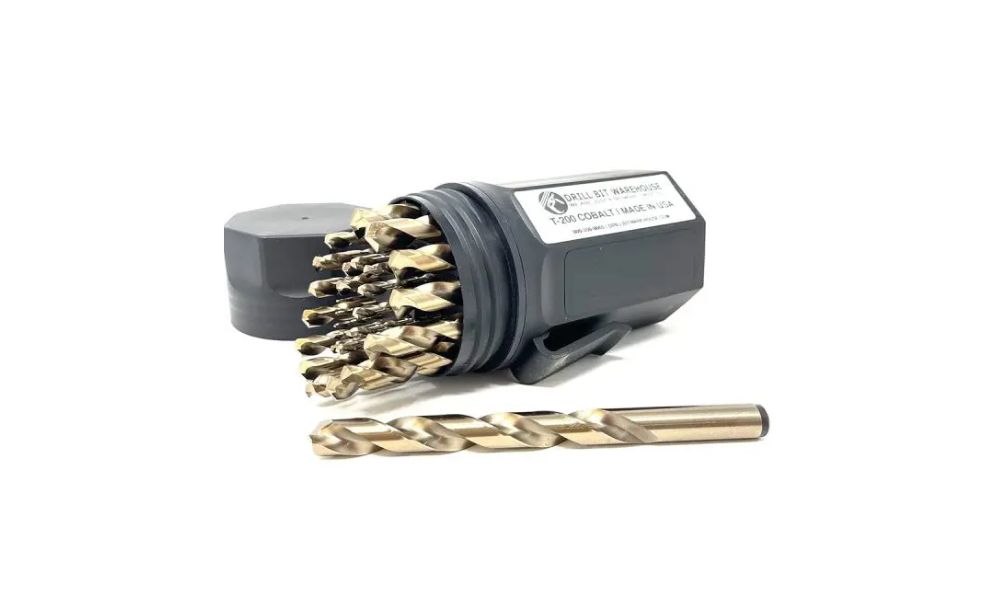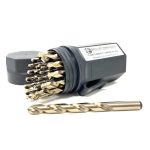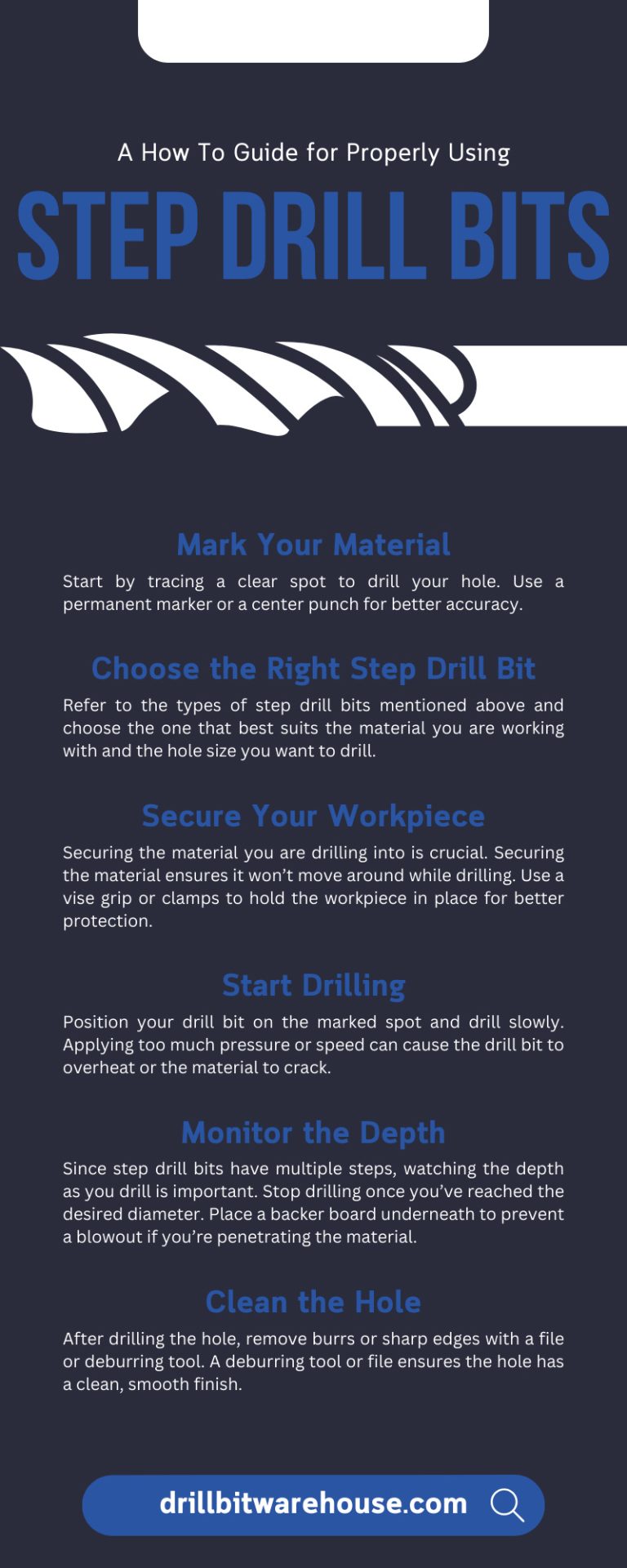Step drill bits are one of the most versatile and efficient tools every DIY enthusiast, hobbyist, and professional should have in their toolbox. These specialized drill bits assist in boring clean, precise holes in tough materials like wood, plastic, metal, and even masonry.
Using step drill bits may initially seem intimidating, whether you’re a novice or an experienced user. Don’t drill in fear. Below, we have a how-to guide for properly using step drill bits. Follow along to learn more, starting with the rundown on step drill bits.
What are Step Drill Bits?
Step drill bits, or unibits or multi-diameter drill bits, are cone-shaped cutting tools with multiple stepped sizes on their fluted surface. They usually have two or three different-sized steps, allowing users to create holes of varying diameters without changing bits.
DIY enthusiasts, hobbyists, and professionals commonly use step drill bits for deburring, enlarging existing holes, and creating perfectly round holes in thin materials. Thanks to their unique design, they can provide precise results with minimal effort.
Step Drill Bit Types
Knowing what each step drill bit type does and how well it can accomplish a task is essential. For example, single-flute step bits are great for thin metals, while straight-flute step bits easily bore through plastic materials. So, using the right type for each task can prolong the tool’s life, ensure your safety, and help you make informed purchasing decisions.
Single-Flute Step Drill Bits
The single flute is the most common drill bit type. These drill bit types are perfect for drilling into thin metals. They have one cutting edge that spirals up the cone, creating a series of incremental steps. The single flute allows for faster drilling and better chip removal, making the process smooth and efficient.
Straight-Flute Step Drill Bits
Straight-flute step drill bits are best for drilling into plastic materials. The straight design creates less friction, preventing the plastic from melting. As the name suggests, these drill bits have straight flutes that run parallel along the length of the cone with each step drawn.
Spiral-Flute Step Drill Bits
Spiral-flute step drill bits are ideal for drilling into harder materials like stainless steel. The spiral design aids in chip removal and reduces friction, which can cause heat build-up. This type of bit is less aggressive, meaning they drill slower but provide more control and accuracy.
Titanium-Coated Step Drill Bits
Titanium-coated step drill bits are perfect for heavy-duty drilling tasks. The titanium coating increases the bit’s hardness and durability, enabling it to withstand the intensity of drilling into tough materials without quickly wearing out. It also reduces heat build-up, extending the tool’s lifespan and ensuring consistently precise results.
Remember, choosing the right bit for the job is key to successful drilling. Understanding each type’s strengths and suitable applications can help you achieve clean, precise holes, extend your tool’s lifespan, and enhance your overall work efficiency.
How To Properly Use Step Drill Bits
Step drill bits are user-friendly tools that you can master with a little practice. Follow these simple steps to ensure you use them correctly.
Mark Your Material
Start by tracing a clear spot to drill your hole. Use a permanent marker or a center punch for better accuracy.
Choose the Right Step Drill Bit
Refer to the types of step drill bits mentioned above and choose the one that best suits the material you are working with and the hole size you want to drill.
Secure Your Workpiece
Securing the material you are drilling into is crucial. Securing the material ensures it won’t move around while drilling. Use a vise grip or clamps to hold the workpiece in place for better protection.
Start Drilling
Position your drill bit on the marked spot and drill slowly. Applying too much pressure or speed can cause the drill bit to overheat or the material to crack.
Monitor the Depth
Since step drill bits have multiple steps, watching the depth as you drill is important. Stop drilling once you’ve reached the desired diameter. Place a backer board underneath to prevent a blowout if you’re penetrating the material.
Clean the Hole
After drilling the hole, remove burrs or sharp edges with a file or deburring tool. A deburring tool or file ensures the hole has a clean, smooth finish.
Maintain Your Drill Bit
Clean out debris from the drill bit between uses. Check for wear and tear often and replace it if needed. Practicing good maintenance helps prolong the life of your step drill bit so it consistently performs well.
Tips for Optimal Results
Improve drilling accuracy, quality, and tool lifespan with the following invaluable how-to guide for properly using step drill bits. Avoid common mistakes, work efficiently, and achieve a professional project finish. Regardless of your skill level, you can elevate your work to the next level with these ideas.
Keep Your Bits Sharp
Using dull step drill bits can lead to inefficient drilling, jagged cuts, and even damage to your tools or workpieces. Therefore, you must sharpen your bits often. Check the contrast of your bits every time you use them and refine them when needed. Filing your bit ensures you don’t need to force it through the material to create smooth and clean holes.
Apply Gentle, Consistent Pressure
Applying too much pressure when using step drill bits can lead to bit breakage or damage to the workpiece. On the other hand, too little pressure can result in inefficient cutting. The key is to apply gentle, consistent pressure that lets the bit cut without forcing it through the material. As each step bit enters the material, increase the pressure slightly to help the bit cut through to the next step. You’ll find the right balance of pressure to achieve clean, precise cuts with practice.
Practice Good Safety Measures
Always prioritize safety when using step drill bits. Always wear goggles to prevent flying debris from getting into your eyes and use gloves to protect your hands because the drill bit will be hot if you touch it. Also, wear ear protection! Wearing earmuffs protects your eardrums from damage if drilling for prolonged periods. Make sure to clamp your workpiece to prevent it from moving during drilling. And remember, never touch a bit immediately after use, as it could be extremely hot.
Mastering the Use of Step Drill Bits
Using step drill bits doesn’t have to be complex. With the right knowledge and techniques, these versatile tools are an invaluable part of your project, allowing you to drill clean, precise holes in various materials. As your go-to source for all things related to drilling, Drill Bit Warehouse is here to provide practical advice and high-quality tools for all your drilling needs.
Why not try our cobalt drill bits for metal if you want to take your drilling game to the next level? These bits can withstand high temperatures and provide long-lasting performance. Try enhancing your drilling process by exploring our range of products today. Don’t forget to revisit our blog for more insightful guides like this one.





